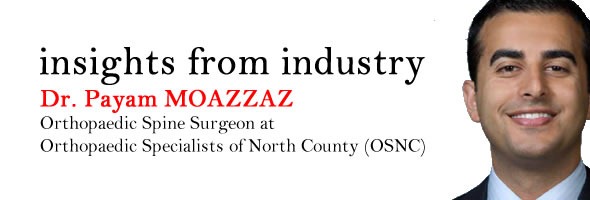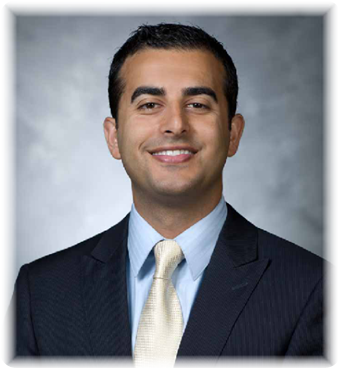
Interview with Dr. Payam Moazzaz, Orthopedic Spiin Surgeon at Othopedic Specialists of North County (OSNC)
Please could you provide a brief outline of robotic spine surgery and its recent history?
Robotic spine surgery is very new, less than 10 years old. There are only 10 hospitals in the US offering it and we are the second hospital in California to offer this technology.
We are one of the sites helping Mazor to develop the technology for further uses.
How was the robotic technology developed?
The technology was developed in Israel. It is based on a CT scan.
They developed a computer software program that takes the patient’s pre-emptive CT scan and helps register that with two X-rays taken in the operating room.
The computer program can go back and forth between the images. It uses this to allow the robot to navigate up and down the spine with extreme accuracy.
What are the benefits of Mazor’s Renaissance guidance system
The Mazor Renaissance guidance system works by taking an oblique X-ray in the operating room. This is a miniscule amount of radiation in comparison to what we used to do in the past.
Previously, we would take six or seven X-rays for each screw to make sure that it was not too close to a blood vessel, the spinal cord or to the nerve root.
Now we take two X-rays at the beginning of the surgery and then can place multiple screws during the operation without the need to take any more X-rays.
So the technology reduces the amount of radiation experienced by the patient?
Yes, but the technology is also of benefit to the whole team providing the healthcare. This is because the entire team in the operating room experiences less radiation.
The operating team in robotic spine surgery typically consists of two surgeons; the scrub nurse, who hands us instruments; the circulating nurse, who gets things that are not in the room; the anesthesiologist and a fourth doctor who monitors all the nerves during the surgery.
Prior to the surgery, the doctor responsible for monitoring the nerves places monitors on the patient’s body and throughout the surgery makes sure the nerves are stable and makes sure the screws are not placed in a position which will affect the nerves.
It was recently announced that you are using an enhancement to the Mazor Renaissance guidance system, could you tell us a little bit about this?
In the enhanced system we use the same technology to enable us to get an intraoperative 3D reconstruction of the spine.
This is the equivalent of getting a post-operative CT scan. Now we can get this without the radiation of a CT scan, which is high.
The beauty of the technology is that at the end of the surgery, the X-ray machine can be brought back in and the 3D reconstruction created without having to take the patient to the CT scanning room. The reconstruction can be done within the operating room.
Then we can continue with the surgery if we need to.
So what is the typical procedure of robotic spine surgery?
Typically once we have done the instrumentation portion of the surgery, we bring the X-ray machine in and do the 3D reconstruction.
Then the X-ray machine leaves the room.
We then usually need to do a decompression then do the fusion part of the surgery.
What kind of patients do you use the technology on?
The majority of my patients are elderly. My areas of expertise are minimally invasive spine surgery and spinal deformity.
The technology is really useful for treating the elderly or those with osteoporotic bones.
This is because when you are doing surgery on patients with osteoporosis, if you are a little bit off with the placement of the screw and you need to reorientate it two or three times, you quickly find that you have nothing left to put the screw in to.
Thus, with osteoporotic patients you really need to get the screw positioning right on your first attempt.
The Mazor technology allows you to do so and get it perfect. This means that you don’t have to make multiple passes thought the bone which ends up weakening the bone and the construct. This essentially leads to failure due to lack of fusion.
The technology is also perfect for revision surgery and surgery on those with spinal deformity.
This is because the surgeon can still place the screws in position even though he doesn’t have the normal landmarks to rely on. Instead the surgeon can rely on the pre-emptive CT scan.
Are there any other benefits to the technology?
The technology also allows the surgeon to make much smaller incisions and do minimally invasive surgery, as we don’t have to rely on our eyes. We can rely on the technology to put the screws in the right spot.
The technology means that the patients heal faster and can leave the hospital sooner. They also tend to need less post-operative narcotics.
They are up walking the same day of the surgery, and it is generally a much more pleasant experience for them.
The smaller incision that we are able to make means that there is less blood loss, less chance of infection and less anesthesia complications. This is because we don’t need to keep the patients anesthetised for long periods of time anymore.
Overall how revolutionary do you think this technology is?
I think the technology is a game-changer.
Previously screws would be put in the wrong place and cause injury to the nerves. This was not recognised until after the surgery when the patient would wake up in pain. Now we can get the screw positioning right during the surgery.
I ask for the technology on every one of my cases now, as I can go to sleep at night knowing the screws are in the perfect place and that the patient is going to wake up and do very well.
How do you think the future of robotic spine surgery will progress?
There is certainly a learning curve with this technology, although I wouldn’t say it is a very steep learning curve. We are still new to this technology and we are getting faster and faster with every case we do.
Right now the technology is being used to put screws in thoracic and lumbar spine and we have started to put screws in the pelvis: so far we have done one case here.
As the technology evolves I see that they’ll be putting screws in the cervical spine with the same technology as well.
Also, in addition to placing screws, I think we will be able to place cages or interbody devices in the spine with this technology.
One day all types of implants will be able to be put in using the Mazor technology.
About Dr. Payam Moazzaz
Dr. Moazzaz specializes in minimally invasive spine surgery and complex spinal deformity of the cervical, thoracic, and lumbar spine. Dr. Moazzaz is passionate about offering his patients surgery through the least invasive approach possible to achieve excellent patient outcomes and quicker recovery times. From nerve decompression and sophisticated fusion procedures to advanced motion-sparing and minimally invasive techniques, Dr. Moazzaz is an expert in the newest advances in spinal surgery.

Dr. Moazzaz completed his surgical internship and orthopaedic surgery residency at the prestigious University of California, Los Angeles Medical Center, consistently ranked as the #1 hospital in the western United States. He then returned to his hometown of San Diego and completed a fellowship in spine surgery with an emphasis on minimally invasive surgery and complex deformity surgery.
Dr. Moazzaz is committed to research and education and advancing the field of spinal surgery. Dr. Moazzaz has published several book chapters and peer-reviewed publications on orthopaedic and spinal surgery and has received numerous research awards and grants. He has presented his research at over twenty national and international meetings and is a key investigator in many ongoing clinical studies.
Dr. Moazzaz is a native of the San Diego North County and strongly feels that service and giving back to the less-fortunate are important aspects of his medical practice. He has volunteered at local San Diego hospitals and traveled to Mexico to perform medical mission trips. When not in the operating room or taking care of his patients in the clinic, Dr. Moazzaz enjoys spending time with his wife Amanda, working out, playing the piano, and traveling.
About Orthopaedic Specialists of North County
Orthopaedic Specialists of North County (OSNC), was founded in Oceanside in 1965 and incorporated in 1973. Over the years, they have treated multi- generations of families, including parents, grandparents and great-grand-parents for their orthopaedic injuries and ailments.
Their 13 board-certified physicians care for accident, sports - or work-related injuries, replacing total joints, or relieving chronic or acute pain. They give patients more lifestyle choices by offering the latest procedures, to help them stay active. For the convenience of their patients OSNC also offers
services such as imaging, urgent care, and physical therapy to help patients recover; regain body strength quicker with less locations to visit.
For more information on their doctors and services please visit: www.orthonorthcounty.com